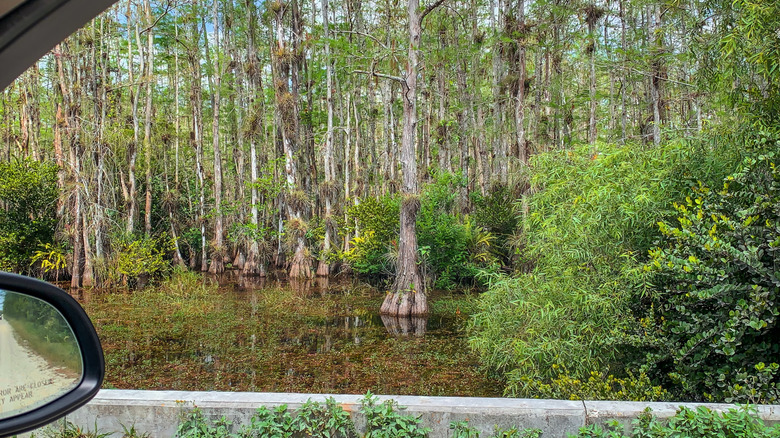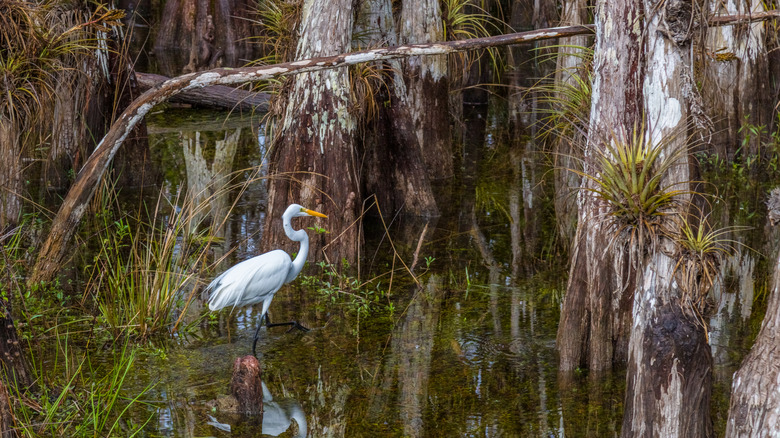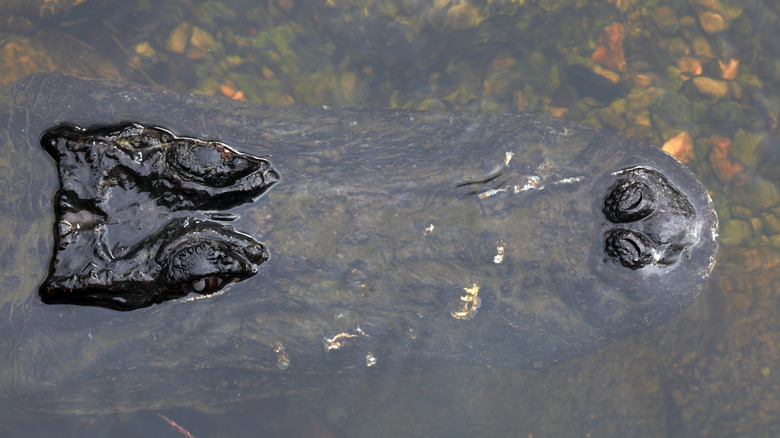A Backroads Route Right Through Florida's Everglades Offers Uncrowded And Up-Close Wildlife Views
South Florida's Everglades National Park is a singular place and one of America's most endangered national parks. At one time, the Everglades ecosystems — famously called the River of Grass by environmentalist Marjory Stoneman Douglas –covered the southern third of the Florida peninsula, including everything south from Lake Kissimmee to the Florida Keys. But draining the "swamp" with canals and flood controls to produce dry land for development and agriculture choked the Everglades, and there are now only a few places where you can glimpse it as it once was.
Most tourists head for one of the two main entrances to Everglades National Park. One leads to the southern tip of Florida, a journey along the 40-mile-long Park Road to a small settlement on Florida Bay — a spot with both wild alligators and crocodiles. The other is at Shark Valley on Tamiami Trail. However, the sights and sounds of the Everglades cannot be contained within the park boundaries, and there are plenty of other spots in the area to glimpse the native flora and fauna if you know where to look.
A road trip along U.S. Highway 41, known as the Tamiami Trail since it was the first to cut across the Everglades and connect Tampa and Miami, provides many opportunities to explore the Glades up close. Big Cypress National Preserve, the quiet and lesser-known neighbor to Everglades National Park, offers numerous pull-offs, boardwalks, trails, and scenic drives to explore. The best of those drives is called the Loop Road, a sometimes-paved and sometimes-not route that winds through cypress strands and hardwood hammocks, far away from tourist crowds — and even farther from civilization.
See the Everglades differently on the Loop Road
The Loop Road is a 24-mile-long road that almost parallels Highway 41, so it's only a Loop if you start and end at the Big Cypress National Preserve's Oasis Visitors Center. A portion is paved, but for most of its length, it's a narrow gravel (and sometimes muddy) path that passes through dense woods and cypress swamps. The road is best tackled with a truck or SUV, especially during summer's wet season. But during the dry season, even small two-wheel-drive cars can make the journey if they proceed slowly and carefully. No matter what you drive, Loop Road is not the fastest route between Points A and B.
The key to enjoying the trip is to slow down, pull over often, and spend time outside soaking it all in. It's a fantastic place to see alligators and birds up close, but you'll miss most of the beauty if you don't get out of the car. In the wooded areas, you'll see hawks, eagles, vultures, and wood storks high in the trees. Around the many culverts, where the road passes over low, flooded cypress strands and gator holes, the area teams with alligators, fish, otters, turtles, and birds like egrets, herons, and anhingas.
You may be surprised to see a few homes along the way. Many belong to members of the Miccosukee Tribe of Indians of Florida. The Loop Road was built in the 1920s during the Florida land boom. One company worked to develop a community called Pinecrest, but the town never happened because the Tamiami Trail bypassed it. Ever since, this backwater area has had a secluded, lawless feeling, and local legend has it that characters like Al Capone hung out here back in the day. Though there's no evidence to support the rumors, the bootlegging feel of the place remains palpable. Today, most visitors simply pass through, snapping photos and returning to the city before nightfall.
Try not to get lost in the Florida Everglades
The park map shows the road beginning at Monroe Station, 49 miles east of Naples, and ending at the Fortymile Bend area on Highway 41, closer to Miami. But you can drive in either direction. On maps, the road is marked as County Road 94/Loop Road, so you shouldn't have too much trouble finding it. The location makes it a good day-long road trip from the east or west coasts of South Florida. Plan to spend at least two or three hours traveling down the 24-mile road once you get there, and give yourself even more time for sightseeing.
The Loop Road is surrounded by wilderness. There's no fee, but there are also no services nearby — no gas stations, restaurants, or hotels. For an immersive experience, you could consider pitching a tent or parking the RV in one of the campgrounds. Or, consider a swamp cottage at the Clyde Butcher Big Cypress Gallery. Butcher is famous for his dramatic black-and-white nature photography, and his gallery offers guided swamp walks and two rental cottages. It's situated on Highway 41 near the Oasis Visitor Center.
Other great places to explore include Fakahatchee Strand State Park and Picayune Strand State Forest, just west of Big Cypress. A visit to the Gulf-side towns of Chokoloskee and Everglades City is also worth your time, and a kayaking or boat trip through the Ten Thousand Islands is not to be missed. It's always a good idea to come prepared with lots of bug spray, drinking water, and sunscreen, no matter what time of the year you visit. Conditions are best for viewing wildlife and outdoor exploring during the winter months — that's when the mosquitoes are fewer, the temperatures are milder, and the humidity less oppressive.


